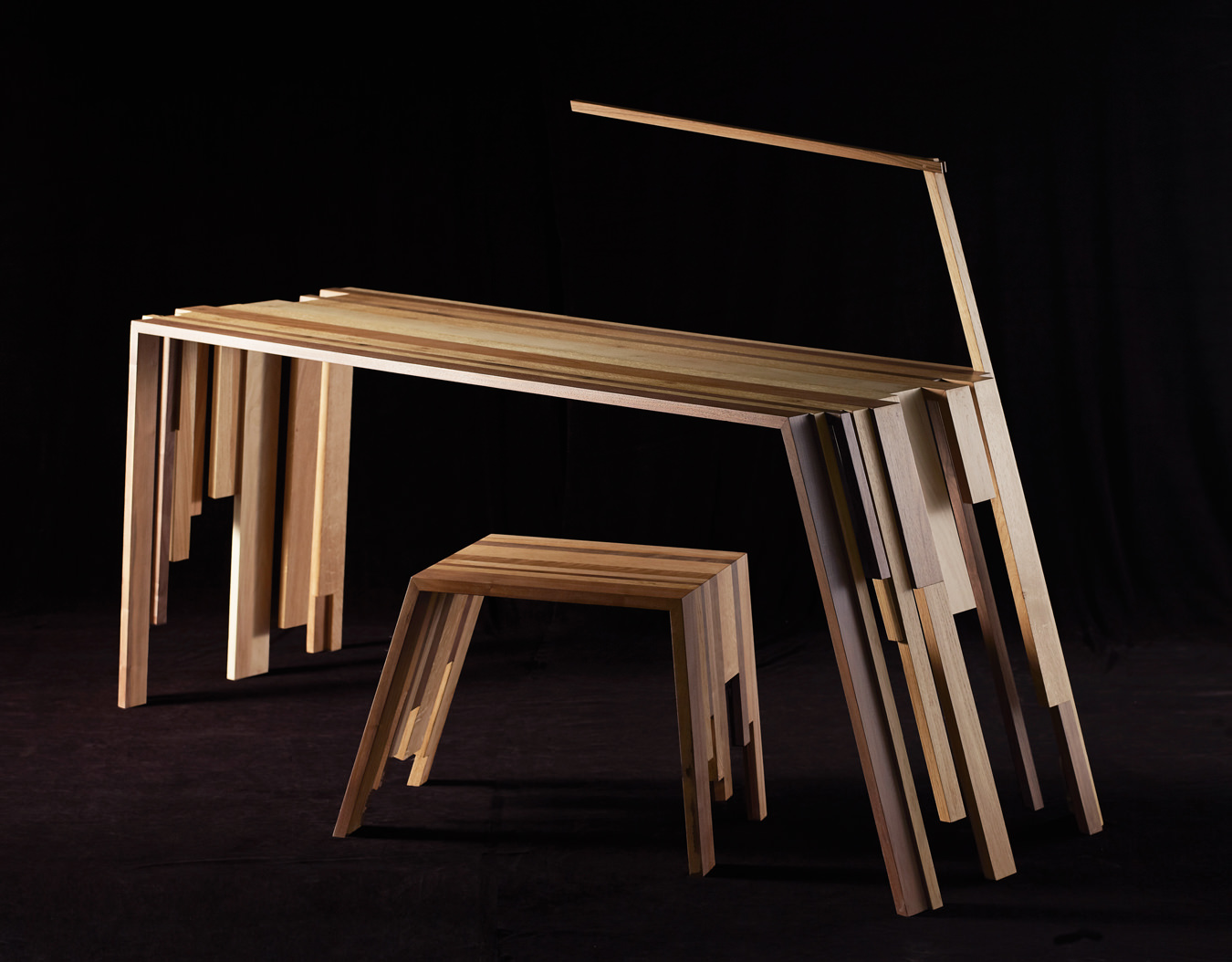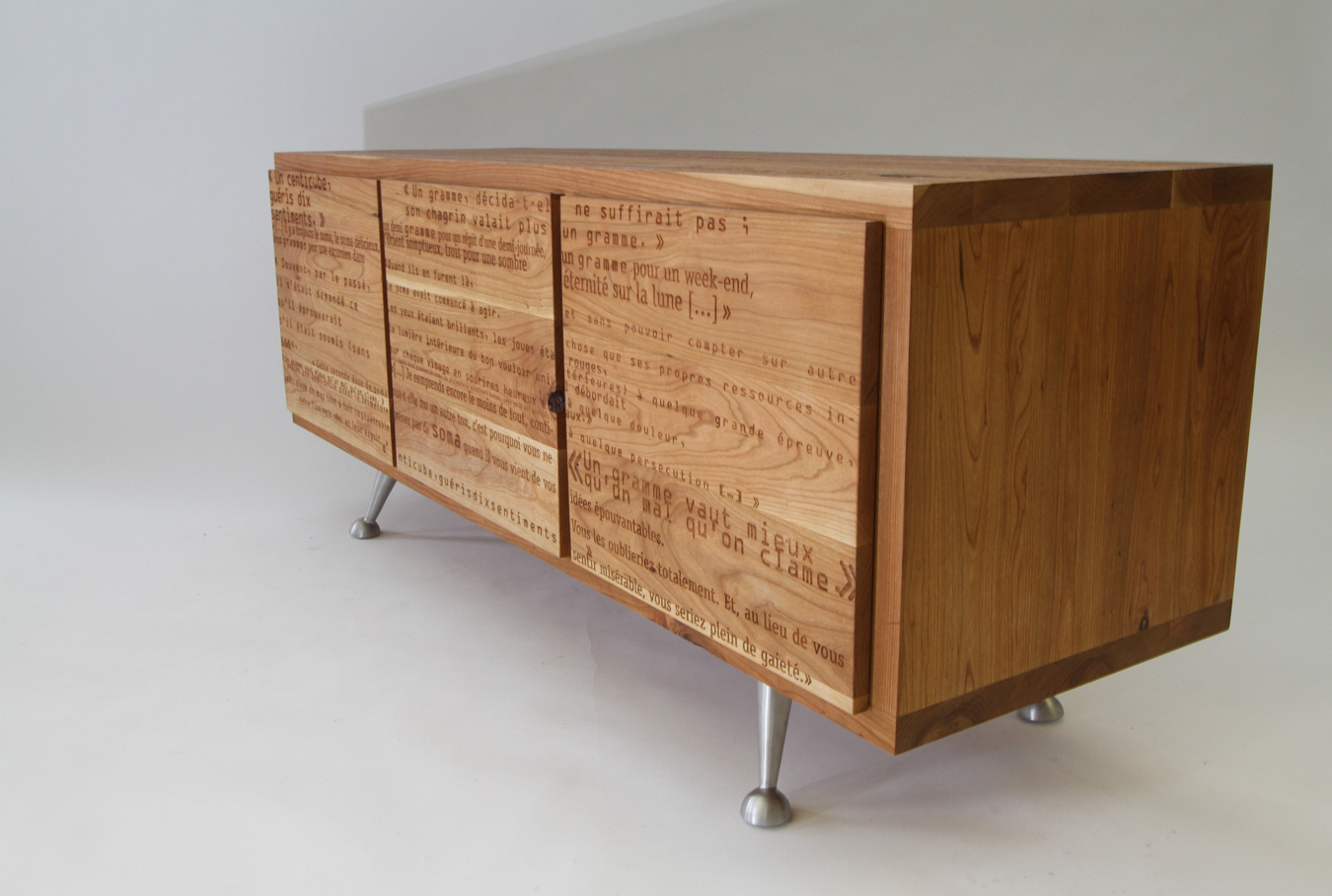-

Hashtag Desk by the Jérôme Dayot Workshop.
-

The Millefeuille lamps collection by Jean-Luc Mare.
-

The Litteratus Buffet by Manu Lerendu, with lasered quotes from Brave New World by Aldous Huxley.
-
Against You Ottoman by Nadine Hajjar.
Furnishings by Barda
The “slow made” movement.
Biochemistry and buffet tables are hardly bedfellows. When was the last time you heard those two terms in a sentence? And yet Catherine Vayssier breezily flits between the two subjects as if it’s commonplace.
“The laser engravings on the doors of this piece are exquisite,” says Vayssier in her studio in Montreal, referring to a stylish console (which was recently exhibited at Wanted Design in New York) emblazoned with text by the Quebec cabinetmaker Manu Lerendu.
Without missing a beat, she brings disease into the conversation, casually saying, “I developed a vaccine against a microbial pathogen for otitis and sinusitis,” as if formulating a way to treat inflammation of the ear and the nasal area is something people just do in their spare time.
The Paris-born Vayssier is an enigma—she’s a scientist as well as the president of Barda, an online shop that sells artisan home products. Launched this past March, Barda is based on a concept modelled after the Slow Food movement that began in Italy. And as the genteel name of that kindred movement implies, it embraces the idea of easing up on the speedy production of offshore factory goods (or fast food) and instead getting to know the people behind the pieces.
The idea is built right into Barda’s slogan: “The human behind the object.” Vayssier, who represents a stable of 10 or so artisans, is an ardent critic of disposable wares and rampant consumerism in general. “I want customers to understand the philosophy behind each project, that it is coming from creators and not a machine,” she says. “The traceability of the product is so important to me. I’m passionate about this.”
She hopes people will cherish the pieces they buy through Barda for a very long time. That shouldn’t be too difficult. There is much to love. Jean-Luc Mare’s Millefeuille collection, for instance, is a rhapsody of rivulets crafted out of delicate Italian paper the artist pieces together to form various lighting sculptures, from a three-dimensional ring shape that sits flush on the wall and pops from the side view, to a striking ceiling pendant.
Ceramicist Christophe Garcia’s offerings bring whimsical elegance to the table. One gourd-like objet is made of fine Limoges porcelain that flaunts a fun, dimpled “skin”, while a design for a white bowl has a brilliant teal interior, its imperfect shape giving it a handmade quality. (There’s that “person behind the product.”)
But before there was Barda, there was the lab. Vayssier spent nine years in one as a microbiologist, then two years in the biotech industry in business development. After that, there was a six-year stint devising active ingredients for luxury leaders in the cosmetics industry.
About two years ago, Vayssier decided to make the shift from scientist to seller of artisan furnishings, which she agrees is atypical. “Yes, it’s unusual,” she says, “but for me science and art are nearer than we think. Before, I was creating molecules, and now I create objects or develop products for the decorative world.”
The stretch from cosmetics isn’t that far, either. “Luxury is luxury. If you sell pricey handbags and furniture and cosmetics, they all have the same marketing concerns,” Vayssier says. “The product is expensive, so you must be better than your competitor. You have to be innovative, and the product must be of the highest quality.”
Vayssier’s bailiwick has always been quality. When she herself was looking for good furniture for her home, she had difficulty sourcing artisanal pieces—they weren’t available, or they were prototypes. “I felt if I was having trouble, others must be too. And it was time to make the decision to try something new. You know, I’m a person for whom it’s very important to make a difference to the community,” she says. “There was an impact when I developed vaccines, and now I want to have the same result in the fine-craft area.”




